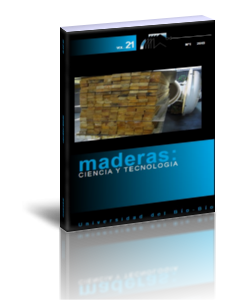An experimental and numerical study of moisture transport and moisture-induced strain in fast-grown sitka spruce
Keywords:
Adsorption, desorption, finite element analysis, glued laminated timber, long-term moisture, long-term moisture transport, moisture diffusionAbstract
The use of fast-grown timber in the manufacture of engineered wood products is increasing; however, the fast growth rate results in a low-density timber that is susceptible to significant swelling and shrinkage deformations under changing moisture content. The current study focuses on the characterisation of the moisture diffusion and swelling/shrinkage of fast-grown Sitka spruce and the prediction of the moisture-induced strain development in Sitka spruce glulam beams under variable humidity cycles. Moisture content evolution and swelling/shrinkage coefficients were measured and the longitudinal swelling/shrinkage was found to be significantly greater than for slow-grown timber. Sitka spruce glued-laminated beams were subjected to controlled relative humidity cycling for 52 weeks and the moisture distribution and moisture-induced strains were measured continuously. Coupled moisture-displacement numerical models, incorporating the experimentally measured material parameters were developed. The effect of the glue-line was found to have an insignificant effect on moisture transport, however, the material orientation greatly influenced the predicted moisture-induced strain. Accurately mapping the material orientation produced significantly better predictions of the experimental results over the 52-week period.
Downloads
References
Avramidis, S. 1989. Evaluation of “three-variable” models for the prediction of equilibrium moisture content in wood. Wood Science and Technology 23(3): 251-257.
Bengtsson, C. 2001. Variation of moisture induced movements in Norway spruce (Picea abies). Annals of Forest Science 58(5): 568-581.
Bourke, M.; Redington, M.; Moloney, S. 2001. Sitka spruce dried to low moisture content for predictable in-service performance as construction elements’, In Proceedings of the 3rd Cost Action E15 Workshop, The drying of softwood species. Helsinki, Finland.
Dai, G.; Ahmet, K. 2001. Long-term monitoring of timber moisture content below the fiber saturation point using wood resistance sensors. Forest Products Journal 51(5): 52-58.
Forsén, H.; Tarvainen, V. 2000. Accuracy and functionality of hand held wood moisture content meters. Technical Research Centre of Finland Espoo, Finland: VTT Publications 420.p79
Fortino, S.; Mirianon, F.; Toratti, T. 2009. A 3D moisture-stress FEM analysis for time dependent problems in timber structures. Mechanics of Time-Dependent Materials 13(4): 333-356.
Fragiacomo, M.; Fortino, S.; Tononi, D.; Usardi, I.; Toratti, T. 2011. Moisture-induced stresses perpendicular to grain in cross-sections of timber members exposed to different climates. Engineering Structures 33(11): 3071-3078.
Gereke, T.; Niemz, P. 2010. Moisture-induced stresses in spruce cross-laminates. Engineering Structures 32(2): 600-606.
Häglund, M. 2007. Moisture content penetration in wood elements under varying boundary conditions’. Wood Science and Technology 41(6): 477-490.
Hailwood, A.; Horrobin, S. 1946. Absorption of water by polymers: analysis in terms of a simple model. Transactions of the Faraday Society 42: 84-92.
Hanhijärvi, A. 1995a. Deformation kinetics based rheological model for the time-dependent and moisture induced deformation of wood. Wood Science and Technology 29(3): 191-199.
Hanhijärvi, A. 1995b. Modelling of creep deformation mechanisms in wood. Technical Research Center of Finland. VTT Publications: Espoo, Finland.
Hassani, M.M.; Wittel, F.K.; Hering, S.; Herrmann, J. 2015. Rheological model for wood. Computer Methods in Applied Mechanics and Engineering 283: 1032-1060.
Merakeb, S.; Dubois, F.; Petit, C.. 2009. Modeling of the sorption hysteresis for wood. Wood Science and Technology 43(7-8): 575-589.
Ormarsson, S.; Cown, D. 2004. Moisture-related distortion of timber boards of radiata pine: Comparison with Norway spruce. Wood and Fiber Science 37(3): 424-436.
Patera, A.; Derluyn, H.; Derome, D.; Carmeliet, J. 2015. Influence of sorption hysteresis on moisture transport in wood. Wood Science and Technology 50(2): 1-25.
Raftery, G.; Harte, A. 2014. Material characterisation of fast-grown plantation spruce. Structures and Buildings 167(6): 380-386.
Sargent, R.; Riley, S.; Schöttle, L. 2010. Measurement of dynamic sorption behaviour of small specimens of Pinus radiata - Influence of wood type and moisture content on diffusion rate. Maderas- Cienc Tecnol 12(2): 93-103.
Siau, J. F. 1984. Transport Processes in Wood. Springer: New York, USA.
Siau, J. F.; Avramidis, S. 1996. The Surface Emission Coefficient of Wood. Wood and Fiber Science 28(2): 178-185.
Simo-Tagne, M.; Rémond, R.; Rogaume, Y.; Zoulalian, A.; Bonoma, B. 2016. Sorption behavior of four tropical woods using a dynamic vapor sorption standard analysis system. Maderas-Cienc Tecnol 18(3): 403-412.
Simpson, W. 1973. Predicting equilibrium moisture content of wood by mathematical models. Wood and Fiber Science 5(1), pp. 41-49.
Skaar, C. 1987. Water in wood. Syracuse University Press: New York, USA.
Srpčič, S.; Srpčič, J.; Saje, M.; Turk, G. 2009. Mechanical analysis of glulam beams exposed to changing humidity. Wood Science and Technology 43(1-2): 9-22.
Svensson, S.; Toratti, T. 2002. Mechanical response of wood perpendicular to grain when subjected to changes of humidity. Wood Science and Technology 36(2): 145-156.
Taylor, G.D.; West, D.J. 1990. Use of stainless steel pins for in-situ measurement of moisture contents in the structural members of a glulam framed church. Journal of the Institute of Wood Science 12(2): 71-76.
Toratti, T. 1993. Long Term Deflection of Timber Beams. Journal of Structural Mechanics 26(3): 19-28.
Wadsö, L. 1993. Studies of Water Vapor Transport and Sorption in Wood, Division of Building materials, Lund University. PhD Thesis, Division of Building materials, Lund University, Sweden.
Wimmer, R.; Kläusler, O.; Niemz, P. 2013. Water sorption mechanisms of commercial wood adhesive films. Wood Science and Technology 47(3): 763-778.
Yoon, S.; Han, B; Wang, Z. 2007. On moisture diffusion modeling using thermal-moisture analogy. Journal of Electronic Packaging 129(4): 421-426.
Zongying, F.; Zhao, J. Lv, Y.; Huan, S.; Cai, Y. 2016. Stress characteristics and stress reversal mechanism of white birch (Betula platyphylla) disks under different drying conditions. Maderas-Cienc Tecnol 16(2): 361-372.

































